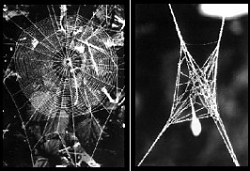 There is an entire family of wasps who use other species to raise their young, and they're a seemingly endless source of sci-fi worthy parasites. I've covered a few of them before, but none is quite so elegant as Hymenoepimecis argyraphaga, a Costa Rican wasp with a fascinating and unique way of keeping its young safe until they can cocoon and turn into adults: it preys on spiders.
There is an entire family of wasps who use other species to raise their young, and they're a seemingly endless source of sci-fi worthy parasites. I've covered a few of them before, but none is quite so elegant as Hymenoepimecis argyraphaga, a Costa Rican wasp with a fascinating and unique way of keeping its young safe until they can cocoon and turn into adults: it preys on spiders.
Spiders wouldn't seem like the best choice for nanny, what with their taste for bugs and all. But the daring Hymenoepimecis argyraphaga uses them anyhow. Unlike many parasitic wasps which lay hundreds or thousands of eggs into their hosts, this meticulous mom carefully avoids getting trapped in a hungry spider's web while it paralyzes the soon to be host temporarily and lays only one egg on the host spider's abdomen. Soon enough a larvae hatches, which stays on the spider's back sucking hemolymph (spider blood) through small holes while the spider goes on as if there's nothing new to see. It continues web building, eating and all its other daily activities for the next one to two weeks.
 Before the spider knows it, the larvae is ready to pupate. But, as it turns out, a spider's web isn't the best place to cocoon up. It's a bit flimsy - designed to catch small flies not hold a heavy, thick cocoon. Though it does have one advantage: the sticky strings keep the cocoon suspended, safe from hungry ants and other creatures which might snack on the helpless wasp-to-be. Luckily (for the wasp, anyhow), the larvae has a special trick up its sleeve to make the web into a sturdy cocoon fortress. It has the spider spin it a thick, small, reinforced cocoon platform instead of a normal web then sit, motionless, in the middle, awaiting its fate.
Before the spider knows it, the larvae is ready to pupate. But, as it turns out, a spider's web isn't the best place to cocoon up. It's a bit flimsy - designed to catch small flies not hold a heavy, thick cocoon. Though it does have one advantage: the sticky strings keep the cocoon suspended, safe from hungry ants and other creatures which might snack on the helpless wasp-to-be. Luckily (for the wasp, anyhow), the larvae has a special trick up its sleeve to make the web into a sturdy cocoon fortress. It has the spider spin it a thick, small, reinforced cocoon platform instead of a normal web then sit, motionless, in the middle, awaiting its fate.
 How the larvae did this, for awhile, was a total mystery. Then some scientists looked a little deeper into what exactly goes on in the spider's last days. It turns out that the baby wasp uses some kind of chemical injected into the spider to achieve its web-building mind control. Instead of the usual five-step web building the spider does to build its regular patterned lair, it repeats only the first two, creating the cocoon ready platform (PDF of descriptive paper). If the larvae is removed just before the spider is killed, it still does a strange web alteration, but eventually goes back to its normal web pattern in a day or two.
How the larvae did this, for awhile, was a total mystery. Then some scientists looked a little deeper into what exactly goes on in the spider's last days. It turns out that the baby wasp uses some kind of chemical injected into the spider to achieve its web-building mind control. Instead of the usual five-step web building the spider does to build its regular patterned lair, it repeats only the first two, creating the cocoon ready platform (PDF of descriptive paper). If the larvae is removed just before the spider is killed, it still does a strange web alteration, but eventually goes back to its normal web pattern in a day or two.
With the platform ready and the spider patiently awaiting his ultimate demise, the larvae then freely molts, kills the spider with a toxic poison, and sucks the remains of the juicy insides out before discarding the carcass and building its cocoon. The platform keeps the growing wasp safe from other creatures until it emerges. The complete change in web-building style is one of the most impressive cases of host manipulation anywhere in the animal kingdom. And just imagine if we had a parasite that could so cleanly alter our behaviors to suit its needs!
